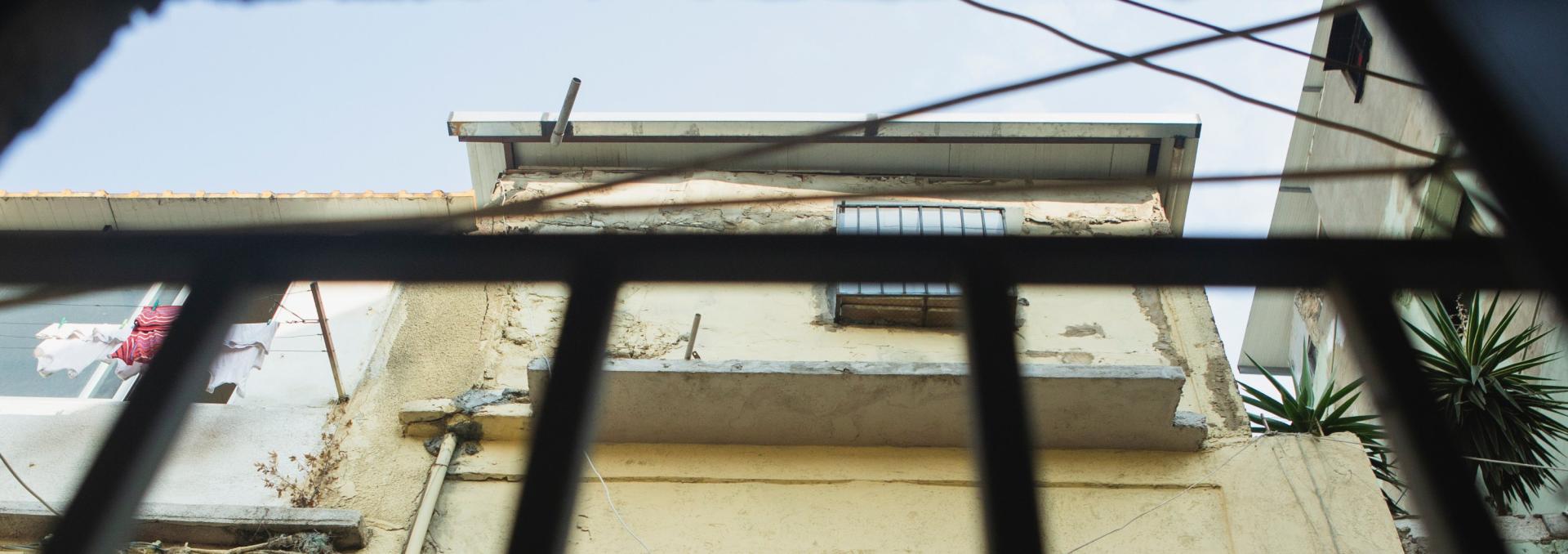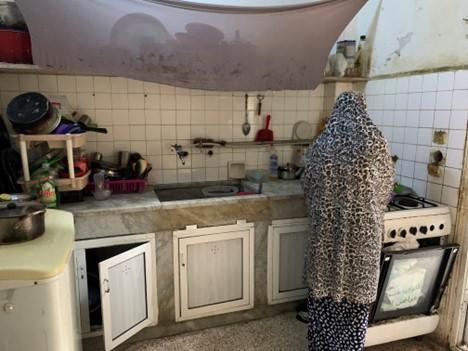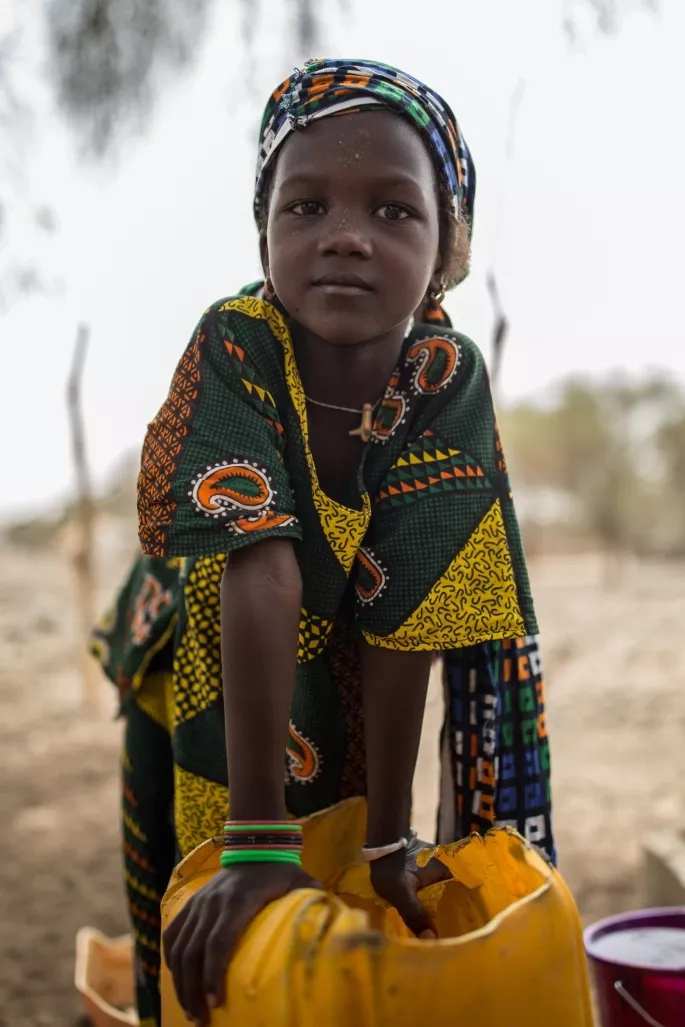

Multi-Purpose Cash Assistance, a respite for Layla’s family
Difficult living conditions
Layla[i], a 31-year-old woman who is pregnant and a Syrian refugee, welcomes us into a small apartment where she lives with her husband and their 3-year-old daughter. Her husband’s parents and his brother with his wife and their children also live with them. The apartment, in the heart of Khandak el-Ghamik, one of the poorest neighborhoods in Beirut, has a dark entrance, a small kitchen, a bathroom and two rooms is the space where they live

A water tank filled with the help of the neighbors together with other items that the family stores in the interior courtyard of the small apartment where Layla, a 31–year-old Syrian refugee, lives with her family. (Elena Garcia Serra / Action Against Hunger)
They have at least an interior courtyard to breath in, where they store a water tank, that is filled thanks to help from their neighbors and some of other items. Layla invites us to sit on an old couch to so we can talk with her. One of the first things she explains to us is that she does not have any privacy, and that she is unhappy, nervous, embarrassed, and not feeling at home.
She is not working, and her husband is barely working because he has an injury in his leg due to an accident, so they have to borrow money from relatives and acquaintances for essential items She and her family are not the only ones struggling, in 2021 it was estimated that around 92% of Syrian refugee households in Lebanon incurred in debt for survival, mostly to buy food (93%), pay rent (49%), essential non-food items (34%), and medicines (34%)[i].
Between December 2019 and October 2021, the price of food and non-alcoholic beverages have risen 1874% in the country[i]. The increase of food prices in the country is adding pressure to vulnerable families struggling to survive. As Layla reflects, “We are reducing the quantity of food that we eat in a day. Instead of eating three meals per day, now we are eating two meals and sometimes one meal and a snack. We mostly feel hungry at night, especially me, because I am pregnant.” In 2021, according to the United Nations, 71% of Syrian refugees living in Lebanon reduced the portion size of meals, and 67% reduced the numbers of meals eaten per day [ii].
Moreover, electricity cuts are making the situation even more difficult, only around four hours of public electricity is available a day depending on the region, meaning that families with no access to fuel generators cannot buy and store certain types of food in the refrigerator because it goes bad quickly, as is the case with this family.

Layla, a 31-year-old Syrian refugee, standing in the kitchen of the small apartment where she lives with her family, with non-functional appliances. (Elena Garcia Serra / Action Against Hunger)
How Action Against Hunger aid is helping Layla’s family
Action Against Hunger responds to alleviate the suffering of families through Food Security and Livelihoods programs in Lebanon, under this sector, the organization reached a total of 6,277 individuals in 2021 (including 2,626 females).
Layla doesn't receive support from the government or other organization but thanks to the French Embassy, she participates in nutrition, including best infant and young child feeding practices awareness activities and receives Multi-Purpose Cash Assistance (MPCA) provided by Action Against Hunger in Beirut. So far under this program the project has been able to reach 607 households, including approximately 3.035 individuals.
As a result of the awareness sessions, Layla now feels more confident on how to breastfeed her future newborn and at what age she should she started introducing solid foods to him, as she clarified: “I learned a lot of information that I didn’t know before, I didn’t know how to breastfeed, how much time should I keep the baby breastfeeding, at what age should we start to introduce solid foods for the baby...” .
On the other side, the Multi-Purpose Cash Assistance helps the family to face the day to day, however, given their situation, they use around 80% of the money received to pay back the debt and the rent, and they have only the remaining 20% for food and other essential needs.
“Before the cash assistance we were worried about the debt, the rent, and how to buy food to feed our children […] We used to buy a small quantity of food but after the assistance, we were able to buy some extra food so we can feed our daughter more nutritious food. We were also able to buy some medicine for my daughter. I used to take them from my neighbors before the assistance.” Layla explains.
Nonetheless, the Multi-Purpose Cash Assistance is not enough, the current situation of the family and the country threaten their lives daily, and they are forced to resort to dangerous coping mechanisms such as buying broken eggs because they are cheaper. They also cannot afford certain types of food such as chicken, meat, and oil.
The protracted crisis in Lebanon is causing more and more families into poverty every day. Multidimensional poverty[i] in the country in 2021 (82%) doubled compared to 2019 (42%)[ii], and 9 out of 10 Syrian refugees living in Lebanon live in poverty[iii]. Consequently, there is an increasing need of humanitarian assistance that ensures a sustainable response for families living in Lebanon like Layla’s.
NOTES
[i] Aliases are used for the interviewees instead of their real names to protect their identities.
[i] UNICEF, UNHCR, World Food Program (September 2021) Vulnerability Assessment of Syrian Refugees in Lebanon. Available at: https://reliefweb.int/attachments/bef919b5-a816-3b63-87b1-1c04cf8f01ce/VASyR%202021.pdf
[i] Lebanon Central Administration of Statistics, Economic Surveys, Inflation in figures. http://www.cas.gov.lb/index.php/economic-statistics-en
[ii] UNICEF, UNHCR, World Food Program (September 2021) Vulnerability Assessment of Syrian Refugees in Lebanon. Available at: https://reliefweb.int/attachments/bef919b5-a816-3b63-87b1-1c04cf8f01ce/VASyR%202021.pdf
[i] The Multidimensional Poverty Index produced by UNDP and the Oxford Poverty and Human Development Initiative, measures poverty by considering various deprivations experienced by people in their daily lives, including poor health, insufficient education, and a low standard of living.
[ii] UNESCWA, Multidimensional Poverty in Lebanon (2019-2021), September 2021. Available at: Multidimensional poverty in Lebanon (2019-2021): Painful reality and uncertain prospects - ESCWA (unescwa.org)
[iii] UN report, Vulnerability Assessment of Syrian Refugees in Lebanon (VASyR) 2021, 28 January 2022 (https://reliefweb.int/sites/reliefweb.int/files/resources/WFP-0000136288.pdf)
